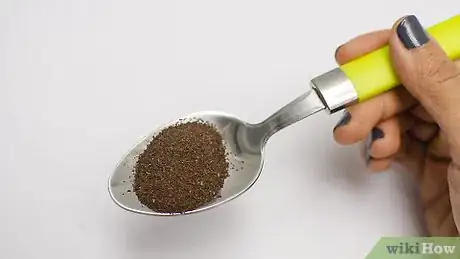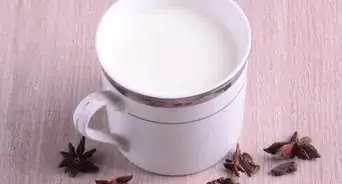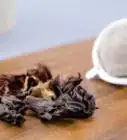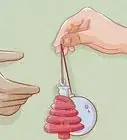This article was co-authored by wikiHow Staff. Our trained team of editors and researchers validate articles for accuracy and comprehensiveness. wikiHow's Content Management Team carefully monitors the work from our editorial staff to ensure that each article is backed by trusted research and meets our high quality standards.
The wikiHow Video Team also followed the article's instructions and verified that they work.
This article has been viewed 11,774 times.
Learn more...
Black tea is made from the oxidized leaves of the camellia sinensis plant, or tea plant, grown all over the world.[1] If you don't know where to start, exploring popular varieties, visiting a tea shop, or looking at online retailers are a great place to begin finding a tea you like. Once you have a tea, you'll want to get your water to the right temperature, and consider whether you want to add any additional flavors to your tea. It won't be long before you are enjoying a hot cup of this delicious beverage.
Steps
Choosing a Tea
-
1Choose a black tea variety that matches your flavor preferences. If you have never tried black tea before, think about the kinds of flavors you like to have in other beverages. Many black teas can have light, fruity flavors, while others are stronger and tend towards malt or citrus flavors. There are even dessert teas that include flavors such as mint, chocolate, or vanilla. A few popular varieties of black tea include:
- Orange Pekoe: A very common black tea that has a sweet aftertaste
- Irish Breakfast: A blend of different black teas that often has a strong, sometimes malty flavor
- Ceylon: A light-colored black tea that smells like citrus
- English Breakfast: A strong blend of black teas that pairs well with milk and sugar
- Darjeeling: A light, fruity black tea that is only grown in the Darjeeling region of West Bengal, India. Be sure to check the label when purchasing, as there are green Darjeeling teas as well.
- Earl Grey: A popular blend of black tea that is flavored with bergamot, giving it a crisp, citrusy flavor[2]
-
2Visit a tea shop and ask for recommendations. If you have a tea shop locally, consider paying it a visit. The salespeople there will be able to recommend a tea based on the flavors you like. You may even be able to sample different kinds of teas, or buy small amounts of tea to take home and try in order to see which you would like best.Advertisement
-
3Look at online retailers and read reviews of black teas. If you are not able to visit a tea shop, consider looking at reviews and descriptions of teas at online retailers to find a tea that sparks your interest. The tea section of your local grocery store will also likely contain a wide variety of black tea to peruse.
Brewing Your Tea
-
1Use a kettle or pot to heat up your water. A stovetop kettle, electric kettle, or even a simple stovetop pot are the ideal methods for heating up water for tea. Each method has slightly different advantages and disadvantages:
- A stovetop pot is easy to use, and most kitchens have one. The down side is that pots can be hard to pour the water out of without splashing or spilling.
- A stovetop kettle is also a very common kitchen tool, though some people find the whistle they make when the water boils to be irritating.
- An electric kettle is one of the fastest ways to boil water, and come in a wide variety of sizes and price ranges. They do require access to an outlet and a clear space, which can be difficult in a small kitchen.
- While you certainly can use a microwave to heat water for tea, this is the least ideal method, as the microwave may not get the water hot enough.[3]
-
2Heat your water to 212 degrees Fahrenheit. This is the ideal temperature for black tea. If you have a thermometer, you can use it to check and see if the temperature of your water is correct. If you do not, take a look at your pot or kettle. The water should put off a moderate amount of steam, and you should see very large bubbles on the bottom of the pot. The water should not be at a rolling boil.[4]
-
3Put your loose tea in the filter or infuser, if you are using one. For each cup of tea you want to brew, use about a teaspoon of loose tea, or one tea bag. Place the filter in your teapot or mug, or put in the tea bag, and pour the hot water over the tea leaves. Ideally your filter or infuser should give the tea leaves room to expand and release their flavors into the water. There are a wide variety of filters and infusers you can use, including:
- A basket infuser, which sits on the lid of a mug. This type of infuser gives the leaves plenty of room to expand, but can be a little difficult to clean.
- A paper filter. Often these are shaped like large envelopes or teabags. They are easy to dispose of once the tea is brewed.
- A tea ball. While these do not give the tea leaves much room to expand, they are easy to clean and come in a wide variety of shapes.
- A strainer. Instead of using a filter, you can also simply put the leaves directly into the hot water, and strain them out when you pour the water into your cup.
-
4Let the tea steep for about five minutes before removing the filter or teabag. If you have any loose leaves still in your cup, filter or spoon these out so you don’t wind up drinking them. Add any milk, lemon, or sweetener as you prefer.[5]
Adding Other Flavors to Your Tea
-
1Add other flavors to your tea depending on your preferences. If you find you don’t like the slightly bitter taste of black tea, you can add a sweetener to help mellow the taste. Sweeteners can be added to any variety of tea. Various choices for sweeteners that work well with tea include:
- Sugar
- Honey
- Agave nectar
- Low-calorie sweeteners such as stevia, aspartame, or sucralose
-
2Add milk to your tea to make it creamier. Adding milk (or a similar non-dairy product) to your tea can add a rich, creamy flavor to black tea. Teas that are dark or strong in flavor are especially good for adding milk to. Note that if you add dairy to your tea, you should not also add lemon juice, as this can cause the dairy to curdle. Some possible additions might be:
- Milk
- Cream
- Half and half
- Non-dairy milks such as soy, coconut, or almond milk
- Dry milk or powdered creamer
-
3Add other fruits or seasonings to your tea to create a custom tea. Many people like to add other ingredients to their tea to essentially make their own tea blend. While lemon, for example, can be added after the tea is brewed, there are many ingredients that can be added to the tea while it is brewing to bring other flavors in. Some possibilities include:
- Dried citrus or citrus peel
- Ginger pieces
- Mint leaves
- Dried fruits, such as apples, mangoes, pears, or berries
- Spices such as cloves, anise, or cinnamon
Things You’ll Need
- Mug or a teacup
- Teapot
- Spoon
- Tea, either loose or in a tea bag
- Tea basket, infuser, or paper filter for loose tea
- Kettle or pot for heating up water
- Thermometer (optional)
References
- ↑ https://www.thekitchn.com/what-you-should-know-about-black-tea-tea-essentials-201046
- ↑ https://www.gayot.com/drink/tea/black-tea/
- ↑ https://www.smithsonianmag.com/smart-news/why-microwaving-water-for-tea-is-a-bad-idea-97452679/
- ↑ https://www.thespruceeats.com/how-to-brew-tea-water-temperatures-766316
- ↑ https://drinks.seriouseats.com/2011/05/tea-technique-how-to-brew-black-tea.html



















































